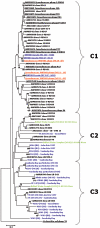Marine and freshwater cyanophages in a Laurentian Great Lake: evidence from infectivity assays and molecular analyses of g20 genes
- PMID: 16820493
- PMCID: PMC1489316
- DOI: 10.1128/AEM.00349-06
Marine and freshwater cyanophages in a Laurentian Great Lake: evidence from infectivity assays and molecular analyses of g20 genes
Abstract
While it is well established that viruses play an important role in the structure of marine microbial food webs, few studies have directly addressed their role in large lake systems. As part of an ongoing study of the microbial ecology of Lake Erie, we have examined the distribution and diversity of viruses in this system. One surprising result has been the pervasive distribution of cyanophages that infect the marine cyanobacterial isolate Synechococcus sp. strain WH7803. Viruses that lytically infect this cyanobacterium were identified throughout the western basin of Lake Erie, as well as in locations within the central and eastern basins. Analyses of the gene encoding the g20 viral capsid assembly protein (a conservative phylogenetic marker for the cyanophage) indicate that these viruses, as well as amplicons from natural populations and the ballast of commercial ships, are related to marine cyanophages but in some cases form a unique clade, leaving questions concerning the native hosts of these viruses. The results suggest that cyanophages may be as important in freshwater systems as they are known to be in marine systems.
Figures



Similar articles
-
Freshwater cyanophages.Virol Sin. 2013 Oct;28(5):253-9. doi: 10.1007/s12250-013-3370-1. Epub 2013 Sep 28. Virol Sin. 2013. PMID: 24132756 Free PMC article. Review.
-
Novel Freshwater Cyanophages Provide New Insights into Evolutionary Relationships between Freshwater and Marine Cyanophages.Microbiol Spectr. 2021 Oct 31;9(2):e0059321. doi: 10.1128/Spectrum.00593-21. Epub 2021 Sep 29. Microbiol Spectr. 2021. PMID: 34585945 Free PMC article.
-
Selection and characterization of cyanophage resistance in marine Synechococcus strains.Appl Environ Microbiol. 2007 Sep;73(17):5516-22. doi: 10.1128/AEM.00356-07. Epub 2007 Jul 13. Appl Environ Microbiol. 2007. PMID: 17630310 Free PMC article.
-
Phylogenetic diversity of marine cyanophage isolates and natural virus communities as revealed by sequences of viral capsid assembly protein gene g20.Appl Environ Microbiol. 2002 Apr;68(4):1576-84. doi: 10.1128/AEM.68.4.1576-1584.2002. Appl Environ Microbiol. 2002. PMID: 11916671 Free PMC article.
-
[Genetic diversity of capsid assembly protein genes (g20) of cyanophage in different natural environment--a review].Wei Sheng Wu Xue Bao. 2013 Nov 4;53(11):1149-57. Wei Sheng Wu Xue Bao. 2013. PMID: 24617255 Review. Chinese.
Cited by
-
Detection of virus mRNA within infected host cells using an isothermal nucleic acid amplification assay: marine cyanophage gene expression within Synechococcus sp.Virol J. 2007 Jun 6;4:52. doi: 10.1186/1743-422X-4-52. Virol J. 2007. PMID: 17553149 Free PMC article.
-
Metatranscriptomic analysis reveals dissimilarity in viral community activity between an ice-free and ice-covered winter in Lake Erie.mSystems. 2024 Jul 23;9(7):e0075324. doi: 10.1128/msystems.00753-24. Epub 2024 Jun 28. mSystems. 2024. PMID: 38940524 Free PMC article.
-
Characterization and genomic analysis of a plaque purified strain of cyanophage PP.Virol Sin. 2013 Oct;28(5):272-9. doi: 10.1007/s12250-013-3363-0. Epub 2013 Sep 27. Virol Sin. 2013. PMID: 24132757 Free PMC article.
-
Molecular Diversity of Cyanopodoviruses in Two Coastal Wetlands in Northeast China.Curr Microbiol. 2019 Jul;76(7):863-871. doi: 10.1007/s00284-019-01700-0. Epub 2019 May 8. Curr Microbiol. 2019. PMID: 31069463
-
Freshwater cyanophages.Virol Sin. 2013 Oct;28(5):253-9. doi: 10.1007/s12250-013-3370-1. Epub 2013 Sep 28. Virol Sin. 2013. PMID: 24132756 Free PMC article. Review.
References
-
- Altschul, S. F., W. Gish, W. Miller, E. W. Myers, and D. J. Lipman. 1990. Basic local alignment tool. J. Mol. Biol. 15:403-410. - PubMed
-
- Barnet, Y. M., M. J. Daft, and W. D. P. Stewart. 1981. Cyanobacteria-cyanophage interactions in continuous culture. J. Appl. Bacteriol. 51:541-552. - PubMed
-
- Benson, R., and E. Martin. 1981. Effects of photosynthetic inhibitors and light-dark regimes on the replication of cyanophage SM-2. Arch. Microbiol. 129:165-167.
-
- Benson, R., and E. Martin. 1984. Physicochemical characterization of cyanophage SM-2. Arch. Microbiol. 140:212-214.
-
- Brittain, S. M., J. Wang, L. Babcock-Jackson, W. W. Carmichael, K. L. Rinehart, and D. A. Culver. 2000. Isolation and characterization of microcystins, cyclic heptapeptide hepatotoxins from a Lake Erie strain of Microcystis aeruginosa. J. Great Lakes Res. 26:241-249.
Publication types
MeSH terms
Substances
Associated data
- Actions
- Actions
- Actions
- Actions
- Actions
- Actions
- Actions
- Actions
- Actions
- Actions
- Actions
- Actions
- Actions
- Actions
- Actions
- Actions
- Actions
- Actions
- Actions
- Actions
- Actions
- Actions
- Actions
- Actions
- Actions
- Actions
- Actions
- Actions
- Actions
- Actions
- Actions
- Actions
- Actions
- Actions
- Actions
- Actions
- Actions
- Actions
- Actions
- Actions
- Actions
- Actions
- Actions
- Actions
- Actions
LinkOut - more resources
Full Text Sources
Research Materials

